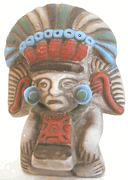
It’s a bit overwhelming to contemplate writing about the plant of the day for Fructidor 28: maize or corn. So I’ll refer you to the excellent Wikipedia article on the subject:
http://en.wikipedia.org/wiki/Maize
The Latin name for corn is Zea mays, a name devised by Linnaeus based on the name for the plant told to Columbus by the Tahino people in 1492. Their name meant “the mother of all.” Maize is known was called Centli in Nahautl (Aztec), Ixim to the Maya and Rxoa for the Zapotecs. We call it corn in English because corn is the generic name for all grains.
http://maize.agron.iastate.edu/name.html
Maize was first domesticated about 9,000 years ago in central Mexico. The wild plant, teosinte, from which maize may be derived, is native to the Balsas River area of southern Mexico. Like wheat, corn developed along with humans and could not survive in the wild. The earliest corn cobs found in archaelogical digs in the Oaxaca Valley date back 6,250 years.
In the Mayan account of the creation of the world, humans were made out of maize dough. The plant was revered as the source of life. An archaeologist, William Saturno, in 2003, uncove
 red a mural from before AD 100 showing the corn god and a woman with tamales on the back of a mighty serpent, emerging from a mountain. Saturno speculates that this was an attempt to reproduce the creation myth.
red a mural from before AD 100 showing the corn god and a woman with tamales on the back of a mighty serpent, emerging from a mountain. Saturno speculates that this was an attempt to reproduce the creation myth.http://magma.nationalgeographic.com/ngm/0312/resources_cre.html?fs=www7.nationalgeographic.com
This picture showing the corn god comes from this web site:
http://www.ancient-empires.com/corgodfig.html
Beginning around 1,500 BC, the cultivation of maize spread rapidly. It was the staple food of Central America, South America and the Caribbean. During the first millennium AD, it spread from Mexico up through Arizona into the Southwest and then Northeast of North America.
In the Southwest, maize was planted using the Three Sisters method of planting. Beans were planted to use the corn stalks as support and squash planted to keep weeds from growing underneath. Corn is planted in the spring and should be “knee-high by the Fourth of July.” There are many different types of maize. Some are grown for flour, others to be popped as popcorn and others to be eaten.
Maize is also made into alcohol: bourbon and chicha. Corn flour or cornmeal is used to make polenta, tortillas, grits and other dishes. Corn cobs have been used to make smoking pipes and also to make biofuel.
Corn is one of my favorite foods and one I consider a serious problem. Because I cannot stop eating it. Doesn’t matter what it is. Give me a bowl of popcorn (hopefully with lots of real butter) or a bag of corn chips or a package of red licorice (made of corn syrup) and I will be unable to stop eating them until they’re all gone. Is this addiction or an allergy?
Food
Corn did cause serious problems for people when it spread across the world because a steady diet of mainly corn will produce malnutrition, due to lack of niacin.
Chelsie VandaVeer explains this well in her article on pellagra at:
http://www.killerplants.com/plants-that-changed-history/20040224.asp
Corn must be eaten with lime (which the Mexicans use to create tortillas), or alkali (in the form of ashes used by Native Americans), or protein sources like beans, chia, fish or meat, in order to acquire the complete range of amino acids necessary to for protein synthesis.
Here’s an article on how to make an authentic tortilla, which notes that the apprenticeship is long:
http://www.public.iastate.edu/~rjsalvad/scmfaq/tortilla.html
This article explains how the Chippewa made hominy using lye and cornmeal:
http://www.ncis.net/brnews/2001/jan2001/cooking.htm
Medicine
Mrs. Grieve recommends using corn silk as a treatment for cystitis and other bladder irritations. She also recommends corn mush as a diet for the invalid.
http://botanical.com/botanical/mgmh/c/corsi105.html
Holidays
Chelsie VandaVeer writes about the festivals held by Native Americans in honor of the new corn in this article:
http://www.killerplants.com/herbal-folklore/20010827.asp
In another article on corn, she explains the origin of the term, “crackers,” for the hill people of the South, attributing it to their penchant for “cracked” corn.
http://www.killerplants.com/plants-that-changed-history/20040427.asp
Other
A recent fad involves creating mazes out of maize, in somewhat the same way yew mazes were popular in the 19th century. Corn grows faster and is tall enough in one season to befuddle the wanderer. This web site provides a list of maize mazes:
http://www.cornfieldmaze.com/site_list.html
I missed this landmark when I was traveling in South Dakota, but here’s a link to the Mitchell Corn Palace:
http://www.travelsd.com/travelspecials/partners/?id=30
I found it on this great list of corn links;
http://maize.agron.iastate.edu/general.html
References:
Salvador, Ricardo, “Maize,” adaptation of an article originally published in The Encyclopedia of Mexico: History, Culture and Society, Fitzroy Dearborn Publishers 1997: http://maize.agron.iastate.edu/maizearticle.html
No comments:
Post a Comment